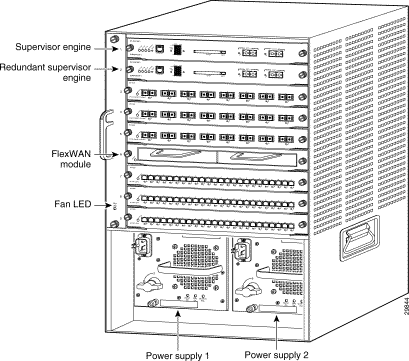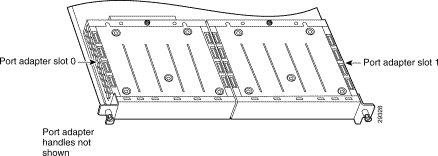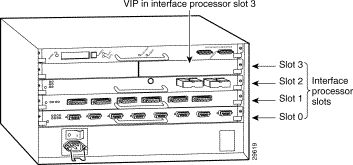|
|

This chapter describes the PA-T3+ and contains the following sections:
The PA-T3+ port adapter provide a full-duplex operation at T3 (45 Mbps) speed. They support both 16- and 32-bit cyclic redundancy checks (CRCs); the default is 16-bit CRCs. You can change the default setting with software commands.
The one-port PA-T3+(=), shown in Figure 1-1, provides up to two network interfaces per Catalyst 6000 family FlexWAN module in the Catalyst 6000 family switches. The two-port PA-2T3+(=), shown in Figure 1-2, provides up to four network interfaces per Catalyst 6000 family FlexWAN module in the Catalyst 6000 family switches.
The Cisco 7000 series router accepts the VIP. The Cisco 7500 series router accepts both the VIP and the VIP. You can install either one or two PA-T3+ or PA-2T3+ port adapters per VIP. The PA-T3+(=) is a one-interface version, shown in Figure 1-1, and the PA-2T3+(=) is a two-interface version, shown in Figure 1-2.
See the Cisco 7200 Series Port Adapter Hardware Configuration Guidelines for information on the number of PA-T3+ port adapters you can install in a Cisco 7200 series router.
The PA-T3+ port adapters can be installed in the single port adapter port of the Cisco 7401ASR router.


The PA-T3+ provides the following features:
The PA-T3+ supports several types of integrated data service units (DSUs). Table 1-1 lists the feature compatibilities of PA-T3+ DSUs.
| DSU | Full Rate Support | Scrambling Support | Subrate Support | MDL1 Support |
|---|---|---|---|---|
DL3100 | Yes | Yes | Yes | No |
Kentrox | Yes | Yes2 | Yes2 | No |
Larscom | Yes | Yes | Yes | No |
| 1MDL (Maintenance Digital Link) 2T3+ serial port adapters support scrambling and Kentrox subrate at the same time. |
The one-port PA-T3+ has six status LEDs and one enabled LED. (See Figure 1-3.)

The two-port PA-T3+ has six status LEDs for each T3+ serial port and one enabled LED
(See Figure 1-4.)

After system initialization, the enabled LED goes on, indicating that the port adapter has been enabled for operation.
The following conditions must be met before the PA-T3+ is enabled:
If any of the above conditions are not met, or if the initialization fails for other reasons, the enabled LED does not go on.
Table 1-2 lists port LED colors and indications.
| LED Label | Color | State | Meaning |
|---|---|---|---|
Enable | Green | On | Port adapter is enabled for operation. |
RCLK | Green | On | A receive clock has been detected. |
FERF | Yellow | On | Framer has detected a far-end receive failure. |
OOF | Yellow | On | Framer has detected an out of frame failure. |
AIS | Yellow | On | Framer has detected an alarm indication signal. |
RL | Yellow | On | Port is in remote loopback mode. |
LL | Yellow | On | Port is in local loopback mode. |
The PA-T3+ serial interface cable, which is a 75-ohm coaxial cable, is used to connect your router to a T3+ serial network. The serial ports on the PA-T3+ are considered to be DTE devices.
The PA-T3+ has one or two T3+ serial ports, each with two connectors (receive and transmit) to which you connect the Cisco 75-ohm coaxial cable. The 75-ohm coaxial cable (Product Number CAB-ATM-DS3/E3=) for the T3+ serial port adapter is available only from Cisco Systems; it is not available from outside commercial cable vendors.
The Cisco T3+ 75-ohm coaxial cable (see Figure 1-5) is available only in 10-foot (3.05-meter) lengths. The typical maximum distance between stations for T3+ transmissions is up to 450 feet for 734A or equivalent coaxial cable, or up to 225 feet for 728A or equivalent coaxial cable.

You can test the DTE-to-DCE cable connection by using the loopback dte command. See the "Using loopback Commands" section, for more information.
Management Information Base (MIB) attributes are readable and writable across ILMI through use of the SNMP.
The one-port PA-T3+ supports all MIB-II (RFC 1213) and the DS3 interface MIB (RFC 1407).
The two-port PA-2T3+ supports MIB-II (RFC 1213) and the DS3 interface MIB (RFC 1407).
This section discusses port adapter slot locations on the supported platforms. The illustrations that follow summarize slot location conventions on each platform:
The Catalyst 6000 family FlexWAN module can be installed in any slot except slot 1, which is reserved for the supervisor engine. The PA-T3+ can be installed into either port adapter bay 0 or bay 1 on a FlexWAN module. Figure 1-6 shows a FlexWAN module with two blank port adapters installed.
 |
Note Slot 1 is reserved for the supervisor engine. If a redundant supervisor engine is used, it would go in slot 2; otherwise, slot 2 can be used for other modules. |

Figure 1-7 shows a Cisco 7206 with port adapters installed. In the Cisco 7206 (including the Cisco 7206 and Cisco 7206VXR as router shelves in a Cisco AS5800 Universal Access Server), port adapter slot 1 is in the lower left position, and port adapter slot 6 is in the upper right position. (The Cisco 7202 and Cisco 7204 are not shown; however, the PA-T3+ can be installed in any available port adapter slot.)

Figure 1-8 shows the front view of a Cisco 7401ASR router with a port adapter installed. There is only one port adapter slot in a Cisco 7401ASR router.

Figure 1-9 shows a partial view of a VIP motherboard with installed port adapters. With the motherboard oriented as shown in Figure 1-9, the left port adapter is in port adapter slot 0, and the right port adapter is in port adapter slot 1. The slots are always numbered 0 and 1.

Figure 1-10 shows a VIP installed in an interface processor slot of a Cisco 7505 router.

 |
Note In the Cisco 7000, Cisco 7507, and Cisco 7513 chassis, the VIP is installed vertically. In the Cisco 7010 and Cisco 7505 chassis, the VIP is installed horizontally. |
This section describes how to identify interface addresses for the PA-T3+ in supported platforms. Interface addresses specify the actual physical location of each interface on a router or switch.
Interfaces on the PA-T3+ installed in a router maintain the same address regardless of whether other port adapters are installed or removed. However, when you move a port adapter to a different slot, the first number in the interface address changes to reflect the new port adapter slot number.
Interfaces on a PA-T3+ installed in a FlexWAN module or a VIP maintain the same address regardless of whether other interface processors are installed or removed. However, when you move a FlexWAN module or a VIP to a different slot, the interface processor slot number changes to reflect the new interface processor slot.
 |
Note Interface ports are numbered from left to right starting with 0. |
Table 1-3 explains how to identify interface addresses.
| Platform | Interface Address Format | Numbers | Syntax |
|---|---|---|---|
Catalyst 6000 family FlexWAN module in Catalyst 6000 family switches | Module-slot-number/port-adapter- | Module slot number—21 through 6 or 9 (depending on the number of slots in the switch) Port adapter bay—always 0 or 1 Interface port—always 0 (for the one-port PA-T3+[=]); 0 or 1 (for the two-port PA-2T3+[=]) | 3/0/0
|
Cisco 7200 series routers | Port-adapter-slot-number/interface-port-number | Port adapter slot—0 through 6 (depends on the number of slots in the router)2 Interface port—always 0 (for the one-port PA-T3+[=]); 0 or 1 (for the two-port PA-2T3+[=]) | 1/0
|
Cisco 7401ASR routers | Port-adapter-slot-number/interface-port-number | Port adapter slot—always 1 Interface port—always 0 (for the one-port PA-T3+[=]); 0 or 1 (for the two-port PA-2T3+[=] | 1/0
|
VIP in Cisco 7000 series or Cisco 7500 series routers | Interface-processor-slot-number/port-adapter-slot- | Interface processor slot—0 through 12 (depends on the number of slots in the router) Port adapter slot—always 0 or 1 Interface port—always 0 (for the one-port PA-T3+[=]); 0 or 1 (for the two-port PA-2T3+[=] | 3/1/0
|
| 1Slot 1 is reserved for the supervisor engine. If a redundant supervisor engine is used, it must go in slot 2; otherwise, slot 2 can be used for other modules. 2Port adapter slot 0 is reserved for the Fast Ethernet port on the I/O controller (if present). |
This section describes how to identify the interface addresses used for the PA-4T+ on the Catalyst FlexWAN module in the Catalyst 6000 family switches. The interface address is composed of a three-part number in the format module number/port adapter bay number/interface port number.
See Table 1-3 for the interface address format.
If the FlexWAN module is inserted in interface processor slot 3, then the interface address of the one-port PA-T3+ is 3/1/0 (module number 3, port adapter bay 1, and interfaces 0). The interface addresses of the two-port PA-2T3+ would be 3/1/0 and 3/1/1 (module number 3, port adapter bay 1, and interfaces 0 and 1).
 |
Note If you remove the FlexWAN module with the one-port PA-T3+ from interface processor slot 3 and install it in module number slot 6, the interface address becomes 6/1/0. The interface addresses for the two-port PA-2T3+ would be 6/1/0 and 6/1/1. |
 |
Note The FlexWAN module physical port address begins with slot 0, which differs from the conventional Catalyst 6000 family port address, which begins with slot 1. |
This section describes how to identify the interface addresses used for the PA-T3+ in Cisco 7200 series routers. The interface address is composed of a two-part number in the format port-adapter-slot-number/interface-port-number. See Table 1-3 for the interface address format.
In Cisco 7200 series routers, port adapter slots are numbered from the lower left to the upper right, beginning with port adapter slot 1 and continuing through port adapter slot 2 for the Cisco 7202, slot 4 for the Cisco 7204 and Cisco 7204VXR, and slot 6 for the Cisco 7206 and Cisco 7206VXR. (Port adapter slot 0 is reserved for the optional Fast Ethernet port on the I/O controller—if present.)
The interface address of the interface on the one-port PA-T3+(=) in port adapter slot 1 is
1/0 (port adapter slot 1 and interface 0). If the PA-T3+(=) was in port adapter slot 4, this same interface would be numbered 4/0 (port adapter slot 4 and interfaces 0).
The interface addresses of the interfaces on the two-port PA-2T3+(=) in port adapter slot 1 are 1/0 through 1/1(port adapter slot 1 and interface 0 or 1). If the PA-2T3+(=) was in port adapter slot 4, these same interfaces would be numbered 4/0 through 4/1 (port adapter slot 4 and interfaces
0 through 1).
This section describes how to identify the interface addresses used for the PA-T3+ in a Cisco 7401ASR router. The interface address is composed of a two-part number in the format port-adapter-slot-number/interface-port-number. See Table 1-3 for the interface address format.
This section describes how to identify the interface addresses used for the PA-T3+ on a VIP in Cisco 7000 series and Cisco 7500 series routers.
 |
Note Although the processor slots in the 7-slot Cisco 7000 and Cisco 7507 and the 13-slot Cisco 7513 and Cisco 7576 are vertically oriented and those in the 5-slot Cisco 7010 and Cisco 7505 are horizontally oriented, all Cisco 7000 series and Cisco 7500 series routers use the same method for slot and port numbering. |
See Table 1-3 for the interface address format. The interface address is composed of a three-part number in the format interface-processor-slot-number/port-adapter-slot-number/interface-port-number.
If the VIP is inserted in interface processor slot 3, then the interface address of the one-port PA-T3+(=) is 3/1/0 (interface processor slot 3, port adapter slot 1, and interfaces 0). The interface addresses of the two-port PA-2T3+(=) would be 3/1/0 and 3/1/1 (interface processor slot 3, port adapter slot 1, and interfaces 0 and1).
 |
Note If you remove the VIP with the one-port PA-T3+(=) from interface processor slot 3 and install it in interface processor slot 2, the interface address becomes 2/1/0. The interface addresses for the two-port PA-2T3+(=) would be 2/1/0 and 2/1/1. |
![]()
![]()
![]()
![]()
![]()
![]()
![]()
![]()
Posted: Tue Nov 12 15:30:11 PST 2002
All contents are Copyright © 1992--2002 Cisco Systems, Inc. All rights reserved.
Important Notices and Privacy Statement.